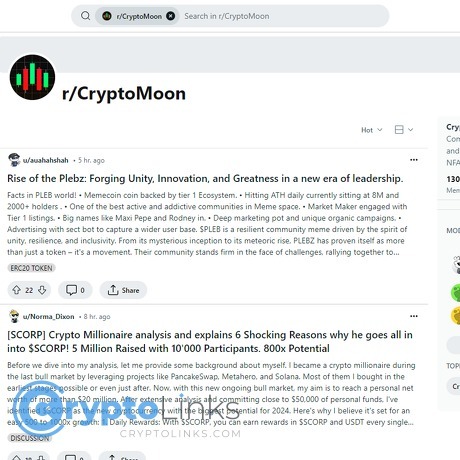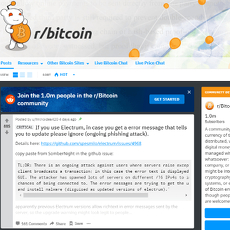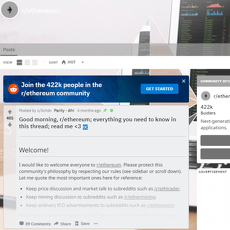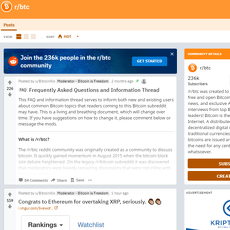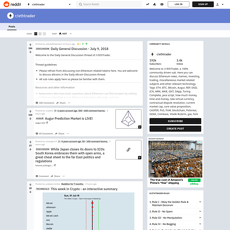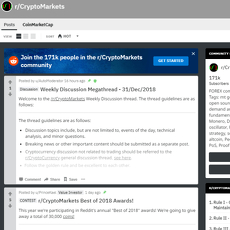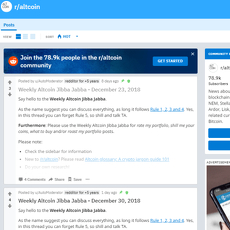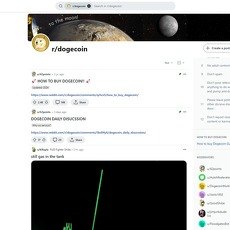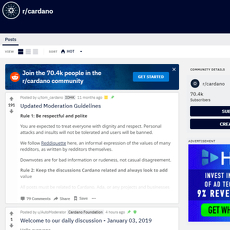r/CryptoMoon Review
r/CryptoMoon
www.reddit.com
r/CryptoMoon review guide: how to use the subreddit, avoid traps, and find real signals (with FAQ)
Is r/CryptoMoon the place to spot the next moonshot—or just noise? If you’ve ever scrolled through endless “100x gem” posts and wondered what’s real, you’re not alone. I’ve spent years reviewing crypto communities, and I’ve seen the same pitfalls cost people time, attention, and sometimes money. In this guide, I’ll show you how to use r/CryptoMoon the smart way: what to read, what to ignore, and how to keep your wallet safe while you explore it.
If you’re hunting early narratives, small-cap plays, and those community-driven “this could moon” ideas, this subreddit can be useful and fun. It can also be messy. My goal here is simple: help you filter fast, research better, and avoid the traps that snare most newcomers.
Why r/CryptoMoon feels chaotic (and how that costs you)
The promise is simple—find coins early. The reality is a flood of mixed-quality content and constant confusion. Here’s what trips people up:
- Name confusion: Many users mix up r/CryptoMoon with r/CryptoCurrency and its “Moons” community points. Different things. Similar names. Lots of wrong assumptions.
- Shills everywhere: You’ll see posts like “100x soon,” “just listed,” “audit incoming,” or “dev KYC’d.” Some are legit; many are coordinated hype or copy-paste templates.
- Low-effort noise: Meme posts or one-liners keep engagement high but hurt discovery. Good research threads get buried if you don’t know how to surface them.
- Hype-to-scam pipeline: Rushed claims, fake partnerships, and “buy now” pressure. You’re nudged to FOMO before you check the contract, liquidity, or team.
- Wasted time: Without a playbook, you’ll bounce between tabs, miss legit signals, and end up being exit liquidity on a trendy ticker.
Social-driven trading is powerful—but it cuts both ways. Security teams have noted how hype accelerates bad behavior; for example, Chainalysis has repeatedly flagged the role of social channels in fueling scams and rug pulls, and firms like CertiK have detailed how “audit” and “KYC” claims are often misused as marketing. Translation: smooth talk isn’t the same as safety.
Typical shill pattern: “Low cap • LP locked • Renounced • CEX soon • Big influencer incoming • Only 50k MC • Don’t miss wave 2”
If you’ve seen one, you’ve seen a hundred. The details matter—always verify.
What you’ll get here (and how it helps)
I’m going to map out how the subreddit actually works—so you can pull signal out of the noise and protect yourself while doing it. Expect:
- Clear purpose and rules: What r/CryptoMoon is (and isn’t), common flairs, and what posts get removed.
- Smart filtering: Sorting tricks, keyword hacks, and how to spot useful threads in minutes.
- Research checklist: A straightforward process to go from post → checks → decision—without guessing.
- Red flags that save money: Copycat whitepapers, fake audits, stealth whale allocations, and contract traps.
- On-chain basics in plain English: Holder concentration, liquidity locks, mint/blacklist functions, and recent deploy patterns.
- FAQ clarity: r/CryptoMoon vs. r/CryptoCurrency’s “Moons,” and why some “MOON” tickers you see on DEXs aren’t Reddit’s Moons.
I’ll keep this practical. No fluff—just what works when you’re moving fast and don’t want to get burned.
How I judge crypto communities (and how you can copy this)
When I evaluate a subreddit like r/CryptoMoon, I use the same set of checks every time. You can apply this lens to save hours and avoid bad bets.
- Moderation quality: Are spam and obvious scams removed? Do mods enforce contract/address disclosures? Are removal reasons consistent?
- Transparency norms: Do posters disclose bags, affiliations, or paid promos? Are there rules against pump groups and referral spam?
- Signal-to-noise ratio: Can I find research and credible discussion without wading through endless memes? Are high-effort posts rewarded?
- Original research: Do users share real tokenomics, contract reads, on-chain data, and sources? Or is it mostly screenshots and slogans?
- Safety culture: Do top comments challenge wild claims? Are on-chain and audit links expected? Are risky mechanics (taxes, mints, blacklists) called out?
Here’s what that looks like in practice:
- Good sign: A post with contract address, GitHub, tokenomics, team links, and a third-party source—plus comments poking holes in the thesis.
- Bad sign: Hype title, no contract, “audit soon,” locked replies, and new accounts spamming the same phrasing across multiple threads.
Spot the difference quickly and you’ll avoid 80% of headaches. And yes, it’s okay to be skeptical. In crypto, skepticism is a feature, not a bug.
Quick note: Nothing here is financial advice. This is about process, not predictions. Use it to sharpen your edge and protect your stack.
So, what exactly is r/CryptoMoon, who actually benefits from it, and when is it worth your time? Let’s answer that next—because once you understand the subreddit’s purpose and vibe, filtering gets a lot easier.
What r/CryptoMoon is (and who actually benefits from it)
r/CryptoMoon is a small, scrappy subreddit where people share “this could moon” ideas: early coins, fresh narratives, stealth launches, and community picks that might run hard. Think of it as a rough scanner for possibilities, not a feed of guaranteed winners. The upside of a smaller sub is speed—threads can surface before they’re everywhere. The downside is noise—lots of shills, thin research, and posts that age like milk.
You’ll find everything from brand-new tickers with a contract address and nothing else, to long-form breakdowns of tokenomics for microcaps on Base, Solana, or BSC. One day it’s “AI + DePIN on Base,” the next it’s “Ordinals are back,” and by Friday it’s “social-fi airdrop farming is the new meta.” If you enjoy the early hunt and you’re comfortable separating story from substance, you’ll feel at home.
“Hype is cheap; conviction is costly.” Your edge is knowing the difference.
Behavioral finance has shown for years that attention spikes drive speculative flows—especially in retail-heavy corners of the market. That’s why a small subreddit can occasionally surface a big move before larger communities pile in. The trick is knowing when a thread is real signal versus a dopamine trap.
The vibe and purpose
The culture is a blend of optimism, FOMO, and the occasional gem of real analysis. A typical day might include:
- Fast pitches: “New L2 gaming token, low MCAP, audit pending, CA inside.” Lots of urgency, few verifiable details.
- Narrative scouting: “Restaking plays are heating up—here’s a shortlist with reasons.” Better than average if there are sources.
- Post-mortems: “What we missed on XYZ—liquidity traps and whale walls.” Useful for pattern-spotting.
- Community hypes/memes: Fun, but low signal. Sometimes a meme hides an early clue, but don’t count on it.
The purpose isn’t to hand you trades. It’s to surface ideas fast so you can research them before the crowd catches on. Treat every post as a starting point, not a finish line.
Who it’s for (and who it’s not)
- Great fit if you:
- Enjoy exploring early narratives and microcaps with imperfect information.
- Can handle volatility and accept that many ideas won’t pan out.
- Have a research habit: checking contracts, liquidity, holder distribution, and team claims.
- Want to spot themes early (AI, DePIN, inscriptions, restaking, social-fi) and build a watchlist.
- Probably not for you if you:
- Want safe, long-term investments with fundamentals and audited histories.
- Prefer hands-off signals or copy-trading over doing your own homework.
- Get rattled by 30–50% intraday swings or illiquid entries/exits.
- Confuse upvotes with quality. Popular doesn’t mean vetted.
If your pulse jumps on every green candle, this kind of subreddit will push all your buttons. That’s the point. The question is whether you can keep your head when a thread is built to make you act fast.
Quick glossary to reduce confusion
- Moon / Moonshot: A high-risk, high-reward play that might run multiples quickly—or go to zero just as fast.
- Shill: A post hyping a coin, often from someone holding it. Not always malicious, but assume bias.
- DYOR: “Do your own research.” Don’t act on posts alone—verify claims yourself.
- Mod: Subreddit moderator. They remove spam and scams, but they won’t catch everything.
- Flair: Labels like Discussion, Research, or News that help you scan what a post is about at a glance.
- CA: Contract Address—copy it from trusted sources only; impostors are common.
- LP: Liquidity Pool—check if it’s locked and for how long; unlocked LP is a rug risk.
- Renounced: When the contract owner gives up control of key functions; not a guarantee, but limits abuse.
- KYC / Audit: Identity or code checks by third parties. Treat them as data points, not safety guarantees.
- MCAP: Market cap—be clear if someone means fully diluted (FDV) or circulating.
- TGE: Token Generation Event—the day tokens unlock/launch; often a catalyst for volatility.
- DEX / CEX: Decentralized vs centralized exchanges; many moonshots start DEX-only.
If that feels like a lot, you’re not alone. Want a quick, simple way to scan posts in seconds, spot the useful ones, and ignore the traps? That’s exactly what I’m breaking down next—rules, flairs, and the post types that actually matter. Ready to make the subreddit work for you instead of against you?
How the subreddit works: rules, flairs, and posts that actually matter
“Follow the rules, and the noise gets quieter.” That’s the mental note I keep any time I open r/CryptoMoon. The sub can be chaotic, but the structure—rules, flairs, and sorting—gives you the map. Learn that map and you’ll stop chasing every shiny post and start picking out the few threads that are actually worth a click.
“Hype is a tax you pay for skipping research.”
Basic rules and flairs to know
Every “moonshot” community has a similar backbone. If you understand it, you’ll filter faster and avoid the stuff that gets people burned.
- Contract addresses required for new tokens. If someone posts a coin without a contract address or ticker + chain, it usually belongs in the trash. Look for exact addresses, not “search it on DEXTools.”
- Disclosures are expected. Good posts say whether the author holds the token, works with the team, or got paid. No disclosure = reason to be skeptical.
- No pump groups or referral links. Anything pushing a Telegram pump, invite bait, or “DM for whitelist” is typically against the rules. Report it and move on.
- Quality over spam. Thin posts, copy-paste Medium pieces, or “buy now” countdowns usually get hit by AutoModerator or the mod team. If they don’t, you still can.
- Always read the sidebar and pinned posts. That’s where updates live—posting rules, flair descriptions, scam alerts, and tools the mods recommend.
Flairs are your first filter. They’re the tags next to a post title, and they quickly tell you how to treat what you’re about to read:
- Research — Usually the highest signal. Expect tokenomics, team notes, contract links, audits, and charts.
- News/Announcement — Listings, launches, partnerships. Treat as starting points, not buy signals.
- Discussion — Narrative talk, questions, sentiment checks. Useful for context and community temperature.
- Warning/Scam — Worth scanning. People often surface red flags here before they spread.
- Meme — Fun, but low signal for decisions.
Quick example: If I see a post titled “[Research] Small-cap L2 index token with audited contracts and 12-month liquidity lock,” that flair earns a click. If it’s “ANNOUNCEMENT: Stealth launch in 15 minutes!!!” with no contract address and a DEX link? Pass.
Post types you’ll see
Research
These are the ones you bookmark. They link the contract, break down supply, team wallets, vesting, roadmap, and ideally an audit or at least a code read. Look for screenshots with source links, not just graphics.
Real sample feel: “Token: 0xABC… on Arbitrum. Supply: 1B, 40% to LP (locked 12 months via Team.Finance), 20% team (6-month cliff, 24-month vest). Audit by SolidProof. Team wallets: 0x123… and 0x456… (no suspicious outbound flows so far).”
Announcements
New listings, launches, partnerships, airdrops. High velocity, high risk. I treat these as “start the research clock,” not “buy.”
Watch for: fake “CEX listing soon” graphics and links to clones. If the team says “audit scheduled,” assume there’s no audit.
Discussions
Useful for catching narratives and sentiment: “Are AI agents the next cycle?” “Which L2s have real users?” Scan for comments that bring data—charts, on-chain links, dev repos.
Memes/Comedy
Enjoy, but don’t trade off them. Upvotes here measure entertainment, not probability of success.
Why this structure matters: research shows social voting can snowball attention without improving quality. A randomized experiment on a Reddit-like platform found that a single early upvote boosted final scores by about 25% on average (Muchnik, Aral, Taylor, Science, 2013). Translation: “Top” doesn’t always mean “best.” It often means “first to get love.”
Mod actions and reporting
Good mod teams remove obvious scams and mass spam, but they can’t catch everything in real time. You’re part of the filter.
- Use the report button. Hit it for missing contract addresses, referral links, “DM me for whitelist,” fake audits, or recycled posts.
- Check the user’s history. Click the username, open “Overview,” and scroll. Patterns pop fast: only shilling brand-new coins? Everything is “100x soon”? Lots of “removed by moderators”? That’s your answer.
- Look for AutoModerator comments. Many subs leave a bot note when removing posts—missing disclosures, no flair, etc. That’s often a good hint for what the sub takes seriously.
There’s also a bigger reason to be strict. Academic work on crypto pump-and-dump groups shows attention spikes around coordinated posts often reverse within a day (see “The Economics of Cryptocurrency Pump-and-Dump Schemes,” Hamrick et al., SSRN 3300157). If you help flag the coordination early, you help the whole feed.
Sorting and filtering for signal
Here’s how I use Reddit’s built-in tools to turn the chaos into something workable:
- Sort by New to spot early threads before they explode. You’ll catch gems here, but you’ll also see more junk—use flairs and your rules filter.
- Sort by Top → Today or This Week for consensus picks and updates. Great for gauging community interest, not so great for discovering true “early.” Remember the upvote snowball effect.
- Use Rising when you have time. It’s a sweet spot for posts that are getting traction but haven’t fully blown up yet.
- Filter by flair using the dropdown under the search bar. I often set it to Research first, then Discussion.
- Keyword search for substance:
- “audit,” “audited,” “Code4rena,” “CertiK,” “SolidProof”
- “tokenomics,” “vesting,” “multisig,” “timelock,” “liquidity lock”
- “contract,” “0x”, “address,” “etherscan,” “arbiscan,” “bscscan”
- Use Google for deep digs. Try: site:reddit.com/r/CryptoMoon tokenomics or site:reddit.com/r/CryptoMoon 0xABC to surface older threads the native search might miss.
- Timebox your scroll. Fifteen minutes on New, five minutes on Top (Today), and you’ll avoid doomscrolling while still catching 90% of the useful stuff.
- Save the good ones. Use Reddit’s Save on posts that pass your first sniff test. You’ll need them when you start checking contracts and holders.
- Optional: RSS for New. If you’re serious about catching early posts, add /new/.rss to the sub’s URL and pipe it into your reader. It’s nerdy—and very effective.
Mini play-through: I sort by New, filter by Research, and scan titles for words like “audit,” “vesting,” or “timelock.” I open 3–5 tabs, check for contract addresses and disclosures, then peek at the author’s history. If anything feels off, I close it. If it holds up, I Save it. That’s my “shortlist” for the next step.
You’ve got the map. Ready for a simple, fast way to turn a promising post into a go/no-go decision—without getting trapped by hype? In the next section, I’ll walk you through a 15–30 minute workflow I use every day. Want it?
Turning r/CryptoMoon into a research engine
Most people scroll, chase upvotes, then wonder why they bought the top. I do the opposite: I use the subreddit as a lead generator and put posts through a fast, repeatable research workflow. It keeps me out of trouble and gets me into the few ideas worth touching.
“In markets, your edge is rarely secret knowledge—it’s the discipline to ignore 95% of noise.”
Here’s the exact way I turn a random hype post into a real decision—without letting FOMO drive the bus.
Fast research workflow (15–30 minutes)
Set a 30‑minute timer. If an idea can’t clear these basics fast, it’s probably not worth your money or attention.
- Skim the post for specifics: contract address, chain, links to site/whitepaper/GitHub, team names, and any disclosures. No address or chain = instant pass.
- Open the website and social links: does the site load quickly, have a clear archived history, and list real people? A “lightpaper” PDF with stock images is a yellow flag.
- GitHub check (if applicable): look for recent commits, unique code, and contributor history. Fresh repo with a single commit last week? Treat claims carefully.
- Whitepaper sanity scan: skim tokenomics, utility, and roadmap. If every “utility” is later or “TBD,” assume the token is narrative-only.
- Block explorer basics: open Etherscan, BscScan, or Solscan and check:
- total supply and top holders
- contract owner and permissions
- LP creation, locks, and recent transactions
- Social proof, not social fluff: scan X and Telegram. Look for real conversations, not “gm” spam. Ratio check: big follower count but tiny engagement per post = likely botted.
- Third-party verification: if the post claims an audit, open it and verify on the auditor’s site (e.g., search directly on CertiK). If they claim a listing or partnership, confirm on the partner’s official channels.
Example flow: A thread hypes “XYZ” on Base, contract 0xabc…123. I check the site (live, no broken links), then explorer: holders tab shows top 10 own 38%, owner has not renounced, LP locked for 30 days via Team.Finance, no mint function, trading limits set to 2%. X account posts code updates with repo links, and a small dev AMA is scheduled in Discord. That’s not a buy signal—but it’s enough to keep on the watchlist and monitor liquidity and holder spread for a week.
Why this works: security firms consistently report that billions are lost yearly to investment scams, with a huge share tied to fake tokens and “too good to be true” launches. Public reports from groups like Chainalysis and Solidus Labs show massive numbers of malicious or low‑effort token launches across EVM chains. You won’t outsmart every scam, but a structured checklist filters out a surprising amount of junk fast.
Red flags that save you money
- Owner can mint or blacklist: contract has functions like mint, setBlacklist, excludeFromFees, setMaxTxAmount with no time-lock or governance. If you don’t understand the permissions, assume risk is high.
- No LP lock or vague “we’ll lock soon” talk: verify LP tokens are locked on a known locker (e.g., Team.Finance, Unicrypt, PinkLock). Screenshots are worthless—check the locker page.
- Anons with no footprint: anonymity isn’t a crime, but zero track record + promises of “CEX soon” and “audit next week” = pass.
- Copy‑paste artifacts: identical whitepapers across multiple tokens, or website text that still mentions a different ticker.
- Unrealistic yields or roadmaps: 5,000% APY, “tier‑1 exchange next week,” “AAA game in 90 days.” Fantasy is free. Shipping is hard.
- Engagement games: wall‑to‑wall hype replies with no critique, thousands of followers with sub‑0.5% engagement, or giveaways that require buys.
- Fake audits/partnerships: PDFs hosted on their own domain, watermarked logos without links back to the partner, or “as seen in Forbes” with no real article.
One I see weekly: a post flexes “liquidity locked,” but the lock is for 7 days. Great for a quick pump, not for your peace of mind.
On-chain checks in plain English
You don’t need to be a solidity dev to catch most traps. Here’s exactly what I look at and how I translate it:
- Holder concentration: open “Holders” on the block explorer.
- Rule of thumb: if top 10 (excluding burn/LP) control >40%, expect violent moves. For meme launches, I’m extra cautious if one wallet holds >10% after the first day.
- Use Bubblemaps to spot connected wallets and cluster distributions.
- Liquidity reality check:
- Find the main pair on DEXTools or GeckoTerminal.
- Click the LP token on the explorer—who owns it? Is it locked? For how long? Is the lock split across many tiny locks?
- Contract permissions and risk:
- On Etherscan/BscScan, hit “Contract → Read/Write.” If owner() returns a normal wallet and not the zero/dead address, the owner still has power. That’s not always bad, but you need to know what they can change.
- Common risk functions: setFees, setMaxTxAmount/setMaxWallet, enableTrading, updateRouter, setSwapEnabled, setBlacklist, mint. If these exist without clear limits, caution.
- For Solana mints, check freeze authority and mint authority on Solscan. If they’re still enabled, the mint can be altered.
- Fresh wallets behavior:
- Open “Latest Trades” on the pair. Are many new wallets buying in bursts and dumping within minutes? That’s classic bot/choreographed activity.
- Click a few buyers: if the wallet was created today and only interacts with this token, that’s not organic flow.
- Proxy and upgradeability:
- Check if the token uses a proxy (EIP‑1967). Upgradeable contracts can change logic later—fine for serious protocols, risky for meme coins.
If this sounds like overkill, remember: one 5‑minute permission check can save you from a “stealth” blacklist that traps buyers. Honeypots are still rampant on DEX launches, and tools like Honeypot.is or TokenSniffer catch many of them quickly.
Engagement signals that actually mean something
Upvotes are a vanity metric. These are the signals I care about:
- Comments that push back: threads where users challenge tokenomics, ask for contract reads, or question LP locks. Good projects don’t fear scrutiny; they answer it.
- Transparent AMAs: recorded AMAs with hard questions and follow‑ups. Bonus points if they publish a post‑AMA recap with timelines they later meet.
- Independent coverage: a third‑party write‑up that includes criticism and on‑chain references beats 20 influencer threads with referral links.
- GitHub and ship cadence: meaningful commits and releases. Even for meme coins, seeing tooling, bots, dashboards, or NFT mints shipped is a good sign of momentum.
- Community testing: users posting reproducible steps, bug reports, or Dune dashboards. Low‑effort “wen CEX?” = low signal.
Real sample: I once flagged a hyped token with 1,200 upvotes because the “audit” linked to a Google Drive, not the auditor’s site. A commenter asked for a link on the auditor’s domain—silence. Within 48 hours, LP was pulled. One skeptical comment saved a lot of wallets.
Here’s a simple emotional check I use: if the thread makes you feel rushed or euphoric, step back. Good opportunities can stand still for 24 hours; bad ones can’t afford to.
Now, once you’ve got a short list of survivors from your research, the next question matters most: how much do you risk, and how do you exit so one winner pays for the losers? Want the exact position sizing, laddered take‑profit, and “no-regret” rules I use when a coin actually looks promising?
Risk management for moonshot hunting
Everyone loves a green candle. But the work that actually keeps your stack alive happens before you click buy. I run moonshot plays with a cold head and a written plan, because once the hype hits, emotions drive bad decisions.
“Rule No.1: Never lose money. Rule No.2: Never forget rule No.1.” — Warren Buffett
Budget and position sizing
I treat moonshots like scratch-off tickets with research. If one hits, great. If not, I’m fine walking away. Here’s the practical setup I use and recommend:
- Cap the sandbox. Decide what percent of your crypto stack is for moonshots (for me, that’s single digits). If you have $5,000 allocated to crypto risk, maybe only $500–$750 is fair game for high-volatility bets.
- Small bites only. Break that sandbox into many attempts. Example: $750 split into 15 tickets at $50 each. One or two winners can pay for the rest.
- Pre-commit exits. Write this down before buying:
- Invalidation (why you’ll cut it): e.g., unlock schedule changes, dev wallet sells, contract upgraded with tax/mint enabled.
- Time stop: e.g., if no traction in 10 trading days, I’m out. It keeps me from babysitting zombie coins.
- Profit ladder: example: take 25% off at 2x, 25% at 3x, let the rest ride with a trailing mindset. The goal is paying yourself while the crowd is just getting loud.
- Fractional Kelly, not YOLO. If you think you have an edge, size at a fraction of Kelly to survive losing streaks. I personally use tiny sizes because edge in microcaps is fragile. If you’re curious, read about the Kelly criterion and then cut it in half (or more).
- Manage slippage and liquidity. For DEX trades, slip out in small chunks to avoid getting taxed by thin liquidity. Keep max slippage tight unless you’re intentionally paying for speed during exits.
- Portfolio heat. I limit total concurrent moonshot exposure. If three microcaps are live, I wait to rotate before adding a fourth. Too many plates spinning leads to panic sells.
There’s behavioral backing for this. Research on retail behavior shows we tend to sell winners too early and hold losers too long (the “disposition effect,” studied by Barber and Odean). A written plan with automatic profit-taking flips that bias in your favor.
Scammer playbook to watch for
Chainalysis has repeatedly shown scams remain a leading category of crypto crime revenue. I see the same patterns over and over, just with fresh paint. When you spot these, slow down:
- Fake partners and listings. Screenshots of “Coinbase listing” or “Binance next week” with no matching post on the exchange’s official accounts. Real listings are public from the source.
- “Audit soon” without a report hash. A legit audit has a PDF with a verifiable hash and a firm you can email. “Scheduled” audits are not risk reducers.
- Stealth launch, private whale list. They brag “no presale,” but a few wallets accumulate before launch, then nuke the pool. Look at first 100 buyers and their connections.
- Airdrop DMs and impostor mods. No real team will DM you a key file or ask you to “reconnect wallet.” Assume every DM is bait.
- Honeypot tokenomics. You can buy but not sell (or sell only with massive tax). Use community tools like Token Sniffer and attempt a tiny test sell before scaling.
- Photoshopped news. Logos, mock press releases, and AI-generated “team at conference” pics. Cross-check on official press pages and event speaker lists.
- Moving goalposts. Every week: new chain, new token, “V2 soon,” migration fees. It’s a treadmill to keep you paying while they exit.
Vendors like Solidus Labs often publish breakdowns of scam token patterns; the exact figures change annually, but the takeaway is consistent: the mechanics don’t need to be clever if investors are in a rush. Slow is smooth; smooth is safe.
Verifying the team the easy way
When a play depends on a team, I want receipts. This is my fast track:
- LinkedIn consistency. Do names, roles, and timelines line up across LinkedIn, Twitter/X, and the project site? Brand-new profiles with 3 connections scream “costume.”
- Shipped work beats promises. Look for prior repos, npm packages, apps, or research. If they claim open-source chops, there should be commits from months or years ago, not last week.
- Recorded AMAs. I like public, timestamped AMAs on YouTube or X Spaces hosted by reputable channels. Anonymous Twitter Spaces that vanish are not proof.
- Conference receipts. If they claim “spoke at ETHDenver,” check the event agenda or YouTube playlist. No listing = big warning.
- Investors you can verify independently. If a fund is involved, it usually appears on the fund’s portfolio page or official X account. Use site search: site:[funddomain] projectname.
- Domain and brand hygiene. Domain age fits the story, SSL is valid, socials are consistent, and the Etherscan/BscScan page links match the official website.
When in doubt, I assume the team is anonymous until proven otherwise and size positions accordingly. Anonymous can build great things—but it raises the bar for technical and community evidence.
Tax and legal basics
I’m not your accountant, but I’ve learned that clean records save pain later. A few guardrails keep you out of trouble:
- Track everything. Keep a simple log: date/time, chain, token, contract address, wallet used, amount in/out, gas fees, and notes (why you bought/sold). Export CSVs from exchanges and explorers regularly.
- Understand taxable events. In many places, swaps are taxable disposals, airdrops can be income, and liquidity pool entries/exits can be events. Rules vary by country—check your local guidance.
- Use tools. Portfolio and tax apps like Koinly, CoinTracking, Accointing, and native DEX trackers help consolidate data. You still need to check their categorization.
- Separate wallets. I keep a “degen” wallet for experiments and a “core” wallet for long-term assets. It makes recordkeeping (and risk) cleaner.
- Beware of advice in comments. Well-meaning strangers are not tax professionals. If numbers get big, a 1-hour session with a crypto-savvy accountant pays for itself.
One last emotional checkpoint I use before any buy: if the idea only feels good because I’m afraid of missing out, I pass. There will be another ticker tomorrow. There’s only one you.
By the way—confused about “MOON” tickers you see on DEXs versus Reddit’s “Moons” you’ve heard about on big subs? That’s where many people get burned. Want the clean, no-nonsense answer next?
FAQ: r/CryptoMoon vs Reddit “Moons” and buying “MOON” tokens
How do you get “Moons” on r/CryptoCurrency?
On r/CryptoCurrency, “Moons” were community points you could earn by contributing—posting, commenting, and getting upvotes that met the sub’s rules. Historically, distributions happened roughly every four weeks, and fluff like memes usually counted less than thoughtful posts. The weighting and rules have changed multiple times, especially after Reddit’s program updates, so the only reliable source is their latest pinned announcements and wiki pages.
- Post and comment with substance, not spam.
- Follow the sub’s rules to avoid strikes that reduce eligibility.
- Check their pinned “Moons” thread for current earning rules or pauses.
Tip: If a stranger DMs you promising to “boost your Moons,” it’s almost certainly a scam.
How do you get “MOON” crypto?
This is where people get wrecked. “MOON” is a common ticker. Multiple unrelated tokens on different chains use it. One guide might refer to a “MOON” on BNB Chain; another might mean a “MOON” on Arbitrum Nova; a third could be a meme coin on Base or Solana. If you buy the wrong contract, there’s no undo.
- Match the chain: Ethereum, Arbitrum, BNB Chain, Base, Solana—be 100% sure which network it’s on.
- Verify the exact contract address: get it from an official source (project site, verified GitHub, or the subreddit/wiki of the project). Copy-pasting from comments is how people lose money.
- Check the explorer: open the token on a block explorer for that chain and confirm:
- Token name, ticker, and decimals match the official info.
- Holders and transfers look organic (not just a cluster of fresh wallets).
- Liquidity is real and ideally locked.
- Test with a tiny swap first: make sure the token is sellable and slippage isn’t absurd.
“I followed a generic ‘How to buy MOON’ page and swapped on the wrong chain.” — I hear this monthly. Many exchange “how to buy” pages are auto-generated for tickers and aren’t endorsements. Treat them as broad instructions, not proof you’ve got the right asset.
Not financial advice. Always confirm chain + contract + liquidity before you touch a DEX.
What exactly are “Reddit Moons”?
They’re community points tied to r/CryptoCurrency that rewarded contributions. Over time, the tech stack, distribution rules, utilities (tipping, governance), and even contract details changed—especially after Reddit’s shift away from Community Points in 2023. The mod team has posted multiple updates about migrations and policy tweaks since then. Treat any static description you see on random blogs as outdated until you verify with r/CryptoCurrency’s current pinned materials.
- Key idea: “Reddit Moons” were designed for that subreddit’s ecosystem. They are not a universal “MOON” coin.
- Always confirm: current contract, chain, and utility via the sub’s official channels.
Are r/CryptoMoon and r/CryptoCurrency’s “Moons” related?
No. r/CryptoMoon is a subreddit for “moonshot” ideas—speculation and early plays people think could run. r/CryptoCurrency’s “Moons” are (or were) community points for contributing to that specific subreddit. Same word, different worlds.
Common trap: Someone posts “MOON is pumping!” on r/CryptoMoon and readers assume it’s the same as Reddit’s Moons. It usually isn’t.
Is r/CryptoMoon legit?
It’s a real community space with a mix of sharp posts, hype, and low-effort shills. That’s normal in early-idea forums. Mods remove obvious spam, but nothing catches everything. I use a 60-second sanity check before I even read a thread:
- Glance at the poster’s history: only shills or a real contributor?
- Look for a contract address, site, and clear disclosures.
- Scan comments for questions and pushback—healthy debates beat blind cheerleading.
Independent research isn’t optional here. It’s the cost of admission.
Quick proof against the biggest confusion
- If you’re trying to earn Reddit “Moons”: go to r/CryptoCurrency and read their latest pinned “Moons” update—rules change.
- If you’re trying to buy a token named “MOON”: confirm chain + contract from official sources before swapping anything.
Security firms and on-chain analytics outfits have repeatedly shown that impersonation and ticker lookalikes are a common scam vector in crypto. The pattern is simple: take a famous name, make a near-identical ticker on another chain, then siphon in careless buyers. A minute of verification blocks a lot of that grief.
Further reading and tools
I maintain a living list of token explorers, contract safety scanners, DEX monitors, rug-check frameworks, and wallet hygiene guides here: My go-to research and safety toolkit. It’s the same stack I reach for when a “MOON” post crosses my screen.
Want the plain-English verdict on whether r/CryptoMoon is worth your time—and what I use alongside it? Keep going. I’ll weigh the pros, the traps, and the best complements next. Which edge do you want most: earlier ideas or fewer false positives?
My verdict: use r/CryptoMoon for discovery—bring your own guardrails
If you treat r/CryptoMoon like a radar, it can widen your field of view and surface narratives before they hit mainstream feeds. If you treat it like a signal service, you’ll likely end up exit liquidity. The sweet spot is idea discovery with tight personal rules.
Bottom line: Use the sub to find threads worth researching elsewhere. Never reverse that order.
I’ve watched the crowd there expose fake audits within minutes and call out photoshopped “major exchange” announcements before they spread. That kind of hive-mind fact-checking is real value. I’ve also seen low-effort hype threads pump thin-liquidity tokens right into predictable dumps—exactly what academic work on pump-and-dumps warns about. If you want receipts, researchers documented coordinated “pump” behavior and the losses that follow: see “The Economics of Cryptocurrency Pump and Dump Schemes” (arXiv). And year after year, Chainalysis shows investment scams and fake promises are still the top money drain in crypto (Crypto Crime Report 2024).
Pros and cons at a glance
- Pros
- Early narrative spotting: You’ll see micro-themes (new L2 quirks, restaking spins, niche airdrops) before they show up on big outlets.
- Engaged fact-checkers: Sharp users often challenge claims, ask for contracts, and cross-verify listings.
- Occasional gems: Once in a while, a research-heavy post breaks down token mechanics better than many blogs.
- Cons
- High noise: Hype, low-effort shills, and recycled narratives clog feeds, especially around new listings.
- Variable moderation: Obvious scams get removed, but gray-area promos slip through during hot markets.
- Risk by design: The entire premise is moonshots. Expect volatility, illiquidity, and incomplete info.
A quick real-world pattern I’ve seen: a post with a slick “audit badge” image gets traction, then someone checks the auditor’s official registry and finds no listing. The thread flips from hype to caution, saving anyone who waited. That’s the best version of this sub—fast community skepticism. The worst is when a meme post leads to concentrated buys from fresh wallets and exits within an hour. The UT Austin study above describes that playbook well, and it still happens.
Alternatives and complements
Don’t put all your discovery power in one subreddit. Build a small, reliable stack:
- r/CryptoMoonShots and r/CryptoCurrency for broader sentiment, policy changes, and mod announcements.
- Official project channels: Discord/Telegram for changelogs and AMAs. Lurk first; avoid DMs. Cross-check “partnerships” against the other party’s official accounts.
- On-chain and market tools:
- Etherscan / BscScan for holder concentration, contract functions, and liquidity locks.
- DEXTools or GeckoTerminal for live pair data and suspicious trading patterns.
- DeFiLlama for TVL and listings; Token Terminal for fundamentals on projects with real fees.
- Dune community dashboards for custom checks on holders and flows.
- Newsletters and research: Free resources from Messari, The Defiant, and primary-source blog posts from teams you’re investigating.
This mix gives you speed (Reddit), verification (on-chain), and context (research). That balance is what keeps you out of most traps.
Wrap-up and next steps
Here’s the simple plan that works:
- Week 1: Lurk. Bookmark the sub, sort by New and Top (Today), and note which usernames consistently bring receipts.
- Practice run: Take three posts and run them through your own checklist without buying. Can you verify claims, contracts, and liquidity? What broke under scrutiny?
- Only then, test size: If you still like a thesis, use small allocations, preset exits, and alerts. No chasing green candles from a fresh thread.
Your edge isn’t finding the thread first—it’s being the one who waits for verifiable facts. Use r/CryptoMoon as a discovery engine, keep your wallet on a short leash, and let patience do the heavy lifting.
None of this is financial advice. It’s a process. The more you stick to it, the less the noise costs you.
CryptoLinks.com does not endorse, promote, or associate with subreddits that offer or imply unrealistic returns through potentially unethical practices. Our mission remains to guide the community toward safe, informed, and ethical participation in the cryptocurrency space. We urge our readers and the wider crypto community to remain vigilant, to conduct thorough research, and to always consider the broader implications of their investment choices.

